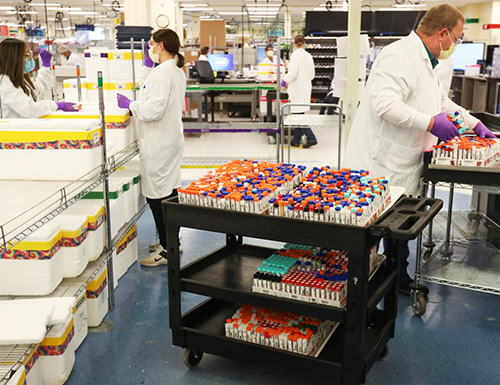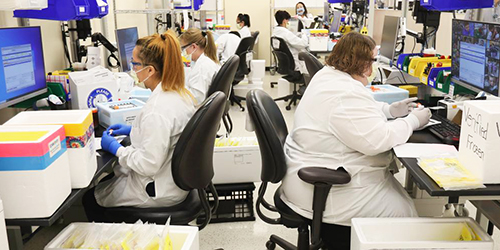As coronavirus pandemic emerged, the Minnesota reference laboratory surged its testing capacity from 2,600 to 20,000 samples per day in an effort to meet ever-increasing demand
Over the past several years, medical laboratory workforce shortages worldwide have challenged clinical laboratory managers to process increasing numbers of clinical laboratory tests with fewer staff. But that did not prepare them for the Herculean task of processing millions of tests each week! According to the CDC’s COVID Data Tracker, as of January 11, 2021, labs nationwide have processed 264,642,631 PCR tests since the start of the SARS-CoV-2 pandemic.
How were medical laboratories able to ramp up their processing capability so quickly? Here’s one example.
A Massive Undertaking at Mayo Clinic Laboratories
On March 12, 2020, Mayo Clinic Laboratories (Mayo) of Rochester, Minn., became one of the first hospital-affiliated reference labs in the country to develop a test for the SARS-CoV-2 coronavirus. At that time, the Minneapolis Star Tribune reported, Mayo was processing 200 to 300 COVID-19 tests/day. By late March through early April, 5,000 to 6,000 COVID-testing samples were arriving daily, but the lab’s capacity topped out at 2,600 samples/day. Today, however, Mayo Clinic Laboratories processes 20,000 samples each day.
How did the Mayo increase its capacity to meet unprecedented demand for COVID-19 testing? According to the Rochester Post Bulletin (Post Bulletin) the laboratory’s tenfold increase in testing capacity “required a massive undertaking of planning, hiring, construction, acquisition of equipment, and a lot of imagination and adaptation.”
The Post Bulletin reported that Mayo Clinic Laboratories started with one advantage—it already owned two automated Roche cobas SARS-CoV-2 systems that had received emergency-use authorization (EUA) from the FDA in March to test for the novel coronavirus.
But as demand for processing kits rose worldwide, the clinical laboratory could obtain only enough kits to process 4,500 tests per day, effectively limiting testing capacity to half, the Post Bulletin reported.
Mayo responded to the supply-chain disruptions by adding less-automated platforms to their testing arsenal. But using systems that required more manpower and took longer to process tests meant lab managers needed to hire even more staff.
During a two-week span in November, the laboratory added 180 new staff, four times the number of new hires in a typical year. To get new hires on the lab floor faster, a two-week orientation course was transformed into a condensed one-day training session. Other spots were filled by employees transferring in from other departments.

“It was kind of crazy. The size of the lab area just kept growing and growing,” said Ben Larson—who volunteered to move from his job as a lab processing assistant to a crew that processed COVID-19 samples in the Hepatitis/HIV Molecular Laboratory—in a Mayo Clinic Laboratories Insights blog post. “I thought it was cool, seeing all the COVID news and being able to say, ‘I’m actually working in the lab that’s doing the testing.’ It’s something I’ll tell my kids and grandkids. When there was the huge pandemic, I was working at Mayo Clinic as one of the people on the frontlines.”
Linda Spiten, Operations Administrator, Mayo Clinic Department of Laboratory Medicine and Pathology (DLMP), credits much of the lab’s success to the 400 DLMP staffers who shifted to different roles for the COVID transformation.
“We were definitely building the car as it was rolling down the street, because so much was hitting us so fast. But our staff is resilient and gracious. Knowing we didn’t have all the answers, but trusting, they took a leap of faith that we could work it out,” she said in the Insights blog post. “Many people made many sacrifices to work nights and weekends. We had people in labs working for weeks on end training in new folks, so we could make sure we had people ready to go. It was incredible.”

Clinical Laboratory Staff Shortages a Widespread Problem
Mayo Clinic Laboratories is not alone in facing supply-chain interruptions and staffing shortages during the pandemic. An Association for Molecular Pathology (AMP) survey in August of 2020 revealed the extent of the problem. More than 85% of respondents reported supply chain interruptions had delayed and/or decreased testing. The shortages most often cited were:
- swabs (60%),
- transport media (53%),
- testing kits (34%),
- reagents (33%),
- testing platforms (32%).
Eighty-five percent of those surveyed said they have staffing shortages as well:
- 66% reported not having enough qualified medical laboratory technologists/scientists, and
- more than half (53%) reported not having enough medical technicians.
To manage these shortages, Mayo Clinic Laboratories found innovative ways to transform its operations. The Post Bulletin noted the lab implemented an employee’s suggestion to mark lab coats with color-coded duct tape, so that new hires could more easily identify supervisors’ roles and departments.
The need for added refrigeration was solved by parking 53-foot refrigerated trucks at the lab for storage of up to 15,000 pounds of dry ice each week, a changed that necessitated installing new doors on the building.
And according to the American Association of Clinical Chemistry (AACC), Mayo Clinic Laboratories also added a third shift to the workday to increase capacity and enable lab technologists to work spaced six feet apart.
“This management team has taught us to think on our feet,” lab worker Jane Masching told the Post Bulletin.
Infectious Disease Specialist Joseph Yao, MD, was tasked with coordinating the surge in Mayo Clinic’s testing capacity to 20,000 samples a day, an amount that still falls short of demand.
“I said we had better be prepared for the worst,” Yao told the Post Bulletin, noting the lab has received up to as many as 50,000 COVID test samples in a single day. “We’re still 15, 20 thousand behind. We’re always behind by about 24 hours.”
But some say there is reason to remain positive. Though the COVID-19 pandemic has clearly stretched clinical laboratories’ ingenuity, staffing, and workflow, Christopher Doern, PhD (above), Director of Clinical Microbiology at Virginia Commonwealth University School of Medicine in Richmond, Va., believes there is a silver lining for the clinical laboratory profession. He says the general public now has firsthand knowledge of the value of clinical laboratory medicine and its important role in patient care.
“Laboratorians are being interviewed on TV,” Doern told Clinical Laboratory News, a publication of the American Association for Clinical Chemistry (AACC). “I hope this will be a success story for our profession,” he said.
Nevertheless, while Mayo Clinic Laboratories is a prime example of how an organization can bring together the resources needed to meet the demand for COVID-19 tests, many clinical laboratories in the United States still struggle to hire more staff for the lab, as well as to obtain the needed volume of SARS-CoV-2 test kits and supplies.
—Andrea Downing Peck
Related Information:
From 2,600 to 20,000: Mayo Clinic Lab Fights to Keep Up with COVID Testing
Mayo Clinic Rolls Out Fast-Tracked COVID-19 Test
The Demand for COVID-19 Testing Is Up, Stressing Labs and Delaying Results
Amid COVID-19 Upheaval, DLMP Staff Steps Up
AMP August 2020 SARS-CoV-2 Diagnostic Testing Survey Results
Laboratories Are Rising to the COVID-19 Challenge‘
The Challenges That Labs Are Facing Are Complex’: Why COVID-19 Test Results Are So Delayed




It’s nice the general public is now more aware of what lab professionals do and of the value and importance of clinical laboratory medicine in patient care. I just wish this equated to the same recognition (and compensation!) for laboratory professionals as it has for nurses.
How is “frontline” defined?
There’s been a lot a talk about hazard pay and prioritization of vaccines for frontline nurses, respiratory therapists, and phlebotomists, but there are also frontline laboratorians who are touching every Covid specimen, have worked long hours – often for months without a break, adapted to changing collections and reagents due to supply-chain issues (and ordering and resulting challenges with computers and interfaces), flexed to handle billing and coding requirements, and implemented or ramped up multiple platforms (often with no additional staffing and complex training requirements) just to attempt to provide testing with reasonable turn-around times to address the demand.
Many laboratory groups on social media have reported organizational salary assessments that provided substantial hourly increases for nurses, but nothing for lab technicians and scientists. (Some report minimal increases for entry-level staff like phlebotomists and lab assistants to progress toward state and federal minimum wage requirements – though competition for labor with fast-food establishment still leave labs short.)
Lab technicians and scientists were also overlooked for vaccines since they aren’t “direct-patient-care.” I understand the need to prioritize vulnerable employees (based on age and medical conditions) as well as employees who are at risk for potential exposure (which definitely includes Lab!), but I also think the risk assessment should include the lab’s ability to back-fill vital positions. Just like critical care nurses can’t be easily replaced, how many blood-bankers, microbiologists, and molecular scientists exist? – and who covers their shifts when they are quarantined or isolated due to Covid infection? Many nurses – especially in surgical areas after procedures resumed – have no additional or increased risk than what they ever had, since patients are being screened for Covid.
When it comes to compensation and vaccines, why are laboratorians a second-thought behind “frontline” nurses? We all play vital roles in patient care!